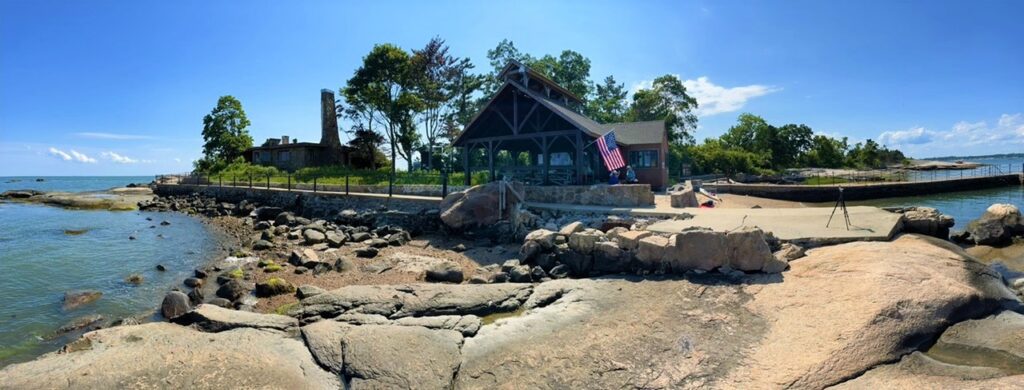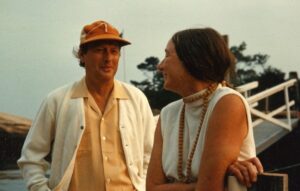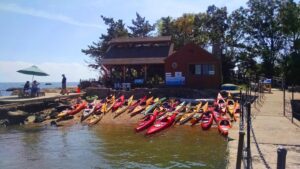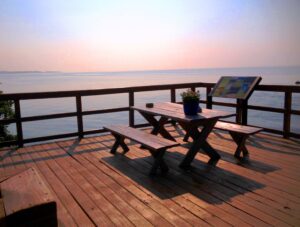c) Connecticut Explored, Summer, 2023
By Shaun Roche
Subscribe/Buy the Issue!

A panoramic view of Outer Island. Seen here are the house that Elizabeth Hird designed and built in the 1960s, at left, and the education pavilion at right.

Basil Rauch (left) and Elizabeth Hird on the island in the 1960s. In 1995 Elizabeth donated the island in her husband’s memory so that anyone could come there to enjoy it and learn about the natural world.
Outer Island is a five-acre granite outcropping at the end of the Thimble Islands chain off the coast of Stony

Outer Island’s education pavilion and beach on a busy summer day. The island is popular summer destination for kayakers and motorboaters and a water taxi is available (for a fee) for those who do not boat.
Creek in Branford. But what the island lacks in size it makes up for in both wild natural beauty and abundant human stories.
The island was once used, as many coastal Connecticut places were, as a summer fishing grounds by Indigenous peoples. These could have been the Wangunk who inhabited villages along the river, the Quinnipiac from the villages of Menunkatuck or Totoket, or other shoreline tribes, who found abundant mussels, clams, lobsters, and fin fish on the island. In those earlier times, Outer Island was called “Two Tree Island,” referring to two large pines that once stood there.

From Outer Island’s back sundeck visitors can see birds, sunsets, and lots of open water, along with Falkner Island and Long Island in the distance.
There are no records of anyone’s living regularly on Outer Island until the late 19th century, when the Thimbles became a sort of resort community. You may wonder what kind of people buy islands. Well, money is certainly a good thing for them to have. But in the case of Outer Island, curiosity, creativity, tenacity, and intelligence were also in abundance among the owners.
The first individual to live on Outer Island semi-permanently was Addison Emery Verrill, a scientist who became Yale’s first professor of zoology. Upon seeing the island, the professor described it as “a wild place, like a jungle.” Verrill’s main area of study was marine invertebrates. This made Outer Island, which Verrill bought in 1889, an ideal summer residence for him. He built a house and seven other buildings there, and he planted dozens of trees, shrubs, and flowers to see what might prove hardy in the island’s climate.
According to the 2011 Biographical Memoir of Addison Emery Verrill, 1839-1926, edited by Wesley R. Coe, for decades Verrill worked all over North America, in such varied places as Newfoundland, Puget Sound, and Bermuda, studying everything under the sea from beautiful corals to giant squid. But he always came back to his favorite island. Professor Verrill later became a curator at Yale Peabody Museum of Natural History, where he built up one of the most valuable zoological collections in the United States. Verrill spent time at Outer Island until his death at age 87 in 1926.
Grace and Leonard Weil were newlyweds when they first saw the island in 1927. Neither of them was from Connecticut. Leonard had grown up in the Midwest and attended the University of Chicago, and Grace was from northern New Jersey. Leonard’s parents had money – and their share of ideas as to what their son should do for a living, including selling stocks and working as a factory boss. But Leonard, an inventive man who eventually studied writing at Yale and created many plays, stories, and essays, had ideas of his own.
When the Weils arrived in Stony Creek with an idea they might buy an island, the notion seemed pretty far-fetched to the local “Creekers” and to the couple themselves. As told in Leonard’s memoir, a booklet edited by his granddaughter Sara Kirschenbaum in 2010 as Outer Island, their realtor, who was admittedly “just sitting around in my BVDs,” said “I didn’t think you was going to buy it [the island]…Lots a people with just a nickel in their pockets come and ask to see things because they’re sort of inquisitive.” But the couple bought it, started a family, and stuck it out there even after the stock market crashed in 1929 and they had to move into the island boathouse to save money. Grace even became a licensed lobster harvester, with pots all around the area.
The couple’s second child, Susan Weil, became an artist who trained at the Académie Julian in Paris. In the 1940s Susan showed fellow artist Robert Rauschenberg the process of making large-scale “blueprints” – a type of artistic photogram – at Outer Island. Susan and Robert went on to produce unique blueprints and had them displayed at the Museum of Modern Art in 1950, the same year they were married on Outer Island. Rauschenberg went on to become one of the leading artists of the 20th century.
The elder Weils passed away in the early 1960s, and in 1964 another couple, Elizabeth Hird and Basil Rauch, bought the island. Rauch was a well-known history professor at Barnard College who focused largely on the Franklin Roosevelt era, the Great Depression, and American foreign policy. Elizabeth Hird was a New York-based architect, and shortly after she and Rauch bought the island, she set about designing a new flat-roofed house in what would later be called the Mid-century Modern style. This is the house that island visitors can see today. Basil and Elizabeth used their island to host concerts in the small amphitheater there, inviting friends and the public to join them. Although they had no children of their own, they relished times when they could invite young students to explore the island’s beaches and tide pools to learn about marine life.
Toward the end of her life Elizabeth Hird decided that she wanted Outer Island forever preserved and opened to the public for education purposes. In 1995 she donated it to the people of the United States as part of the Stewart B. McKinney National Wildlife Refuge. Elizabeth also had the forethought to create a large fund that still finances island projects, seasonal staffing, and field trips from urban schools.
Today everyone is welcome to visit Outer Island, which is open to the public daily from late May through late September. Visitors can admire the island’s bird and marine life, its large glacial boulders, and its gorgeous views and sunsets. This summer people may also view a small exhibit exploring Outer Island’s history through historical photos and books.
Shaun Roche is the visitor services manager at the Stewart B. McKinney National Wildlife Refuge, of which Outer Island is a unit. He has an M.A. in Public History from Central Connecticut State University and has worked for the U.S. Department of the Interior for 18 years.
[SHPO Logo]
Connecticut Explored received support for this publication from the State Historic Preservation Office of the Department of Economic and Community Development with funds from the Community Investment Act of the State of Connecticut.
